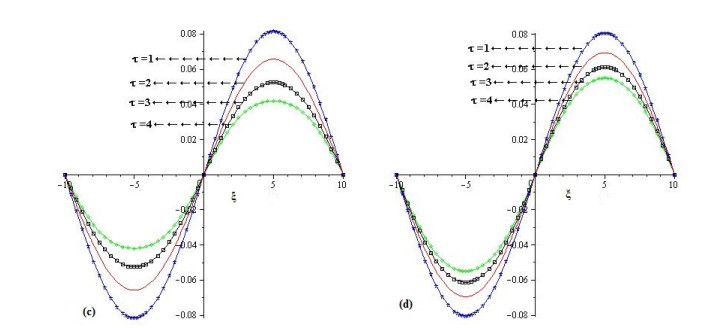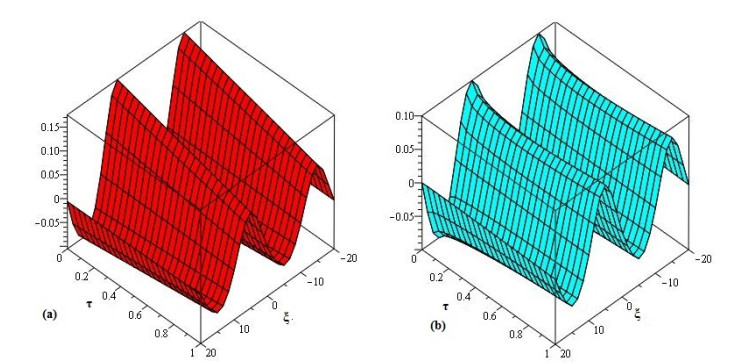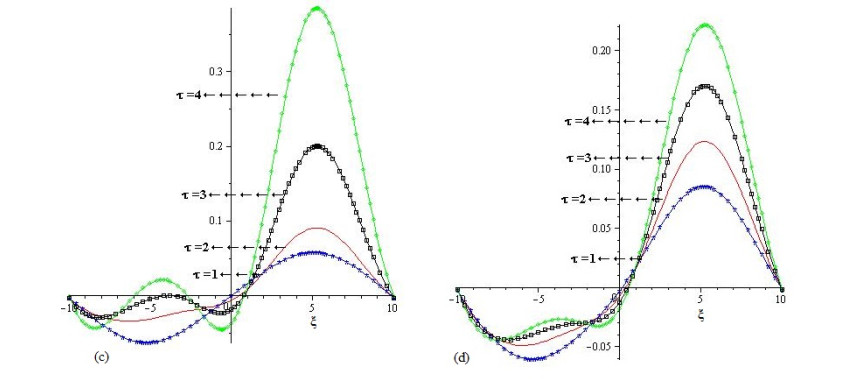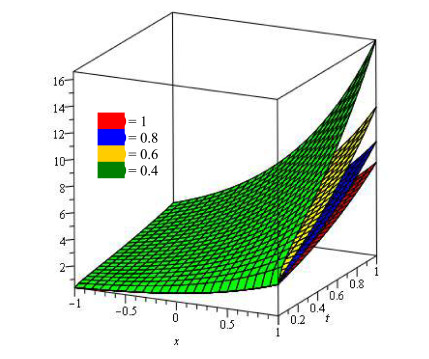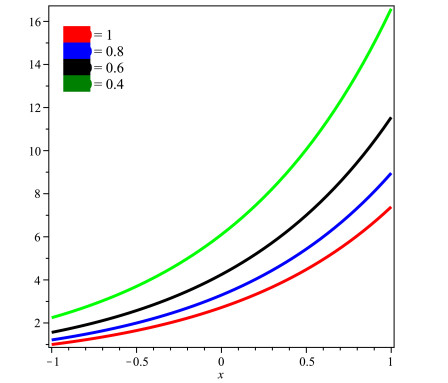1.
Introduction
In the last few decades, the researchers have shown significant interest in fractional calculus in different areas, such as edge detection, electromagnetic, engineering, viscoelasticity, electrochemistry, cosmology, turbulence, diffusion, signal processing material science, physics and acoustics. It has been proved by many researchers that the integer-order models are generalized by fractional-order portray the complex phenomena in a very effective approach [1,2,3]. Various dynamical systems in physics and engineering are also modeled by using fractional-order differential equations. Many researchers have contributed a lot to provide an outstanding history of the derivative of fractional-order, such as Caputo [4], Yin et al.[5], Rashid et al., Arife et al. [6] and Oldham and Spanier [7,8].
The majority of science problems are nonlinear and it isn't easy to find its analytical solutions. The physical problems are mostly designed by using higher nonlinear partial differential equations (PDEs). It is challenging to find the exact or analytical solutions for such problems. However, in the last several centuries, many scientists have made significant progress and adopted various techniques to solve nonlinear PDEs. Recently in [9,10,11,12], Arqub et al. have implemented the Hilbert space reproduction kernel technique along with the iterative computational method to extended the semi-analytical approaches to other time fractional-order PDEs. In [13], the author examined approximate methods for certain groups of Robin time-fractional PDEs by fitting the kernel reproduction algorithm [14]. Sadly, many nonlinear problems can not be solved by analytical techniques. Moreover, the traditional numerical methods have to provide linearization, transformation, discretization and perturbation to solve the nonlinear models [15,16,17,18,19,20].
In 1980, Adomian developed an effective technique is known as Adomian Decomposition Method (ADM) to solve differential equations describing physical phenomena [21]. Further, ADM is modified by using Laplace transformation. As a result, a new method is developed, known as Laplace-ADM (LADM). LADM possesses the basic properties of both Laplace transformation and ADM. S.A Khuri [22] introduced LADM. This technique works effectively for PDEs of both initial and boundary value problems. LADM is also used in several research article to achieve an analytical solution, such as Whitham-Broer-Kaup equations [23], third-order dispersive fractional PDEs [24], fractional-order telegraph equations [25], fisher's equation [26], time-fractional model of Navier-Stokes equation [27] and Keller-Segel equation [28].
In the current article, the analytical solution of the following Swift-Hohenberg (SH) equation.
where a and b are parameters. This is among the most fundamental equations suggested by Jack Swift and Pierre Hohenberg in 1977, which is related to the temperature and thermal convection of fluid dynamics [29]. A nonlinear parabolic equation is the SH equation, which also explains the formation process in liquid surfaces bounded along a horizontally well-conducting boundary. The broad field of SH equation is used in engineering and science problems from hydrodynamics of fluids to complex patterns [30,31]. Density gradient-driven liquid convection occurs in streams of geophysical fluid in the atmosphere, oceans and mantle of the earth. The mathematical model for the convection of Rayleigh-Benard includes the equations of Navier-Stokes combined with the temperature formula for transport. The S-H equation plays a vital role in the various branches of science, including fluid mechanics, such as laser studies [32] and Taylor-Couette flow [30] nonlinear optics.
The SH equation's solution was analyzed by some researchers using various methods, such as Vishal et al., that used the Homotopy Perturbation Transform Method (HPTM) [33]. The Homotopy Analysis Method (HAM) [34], Merdan, who used the method of variational iteration utilizing the Riemann-Liouville derivative [35], Khan et al., who used the differential transform method [36], Prakasha et al., applied is residual power series method and others [37,38,39,40].
In this research work, the analytical solution of SH equation is investigated by using Laplace Adomian decomposition method. In the prior literature, the solution of SH equation was handled by using Variational iteration method and Homotopy analysis method. It is observed that the proposed method is simple and straightforward as compared to other existing techniques. Moreover, the suggested method has greater accuracy and requires fewer calculations than other methods. The method is applied easily to achieve the solutions of fractional problems. The representation has confirmed the closed relation between the exact and obtained results. The fractional-order solutions are convergent to the solution of the integer-order problem.
2.
Definitions and preliminaries concepts
2.1. Definition
The Caputo definition of the fractional derivative of order β is described as [1,2,3,7]
Hence, we have the following properties [1,2,3,7]
2.2. Definition
The Laplace transform of G(s) of g(t) is defined by [22]
2.3. Definition
The Laplace transform of fractional derivative is [22]
3.
LADM idea for FPDEs
In this section, LADM is implemented to solve FPDEs [22].
For this first consider the following FPDE, that is
with initial condition
The fractional derivative in equation (3.1) is expressed in Caputo sense. The linear and nonlinear terms are denoted by L and N respectively. The q is the sources term.
Taking both sides Laplace transformation of Eq (3.1),
The LADM solution is [22]
The nonlinear term in the problem is expressed as
where
is called Adomian polynomials.
substitution (3.4) and (3.5) in Eq (3.3), we get
Applying the decomposition method, we get
In general, it can be written as
Using inverse Laplace transform to Eq (3.8)
4.
Numerical examples
4.1. Example
Consider the fractional equation SH with the form dispersion [33,34,39]
with initial condition
Taking Laplace transform of Eq (4.1),
Using inverse transformation
Using ADM procedure, we get
where the nonlinear terms in the above equations are represented by Adomian polynomials Aj [41]. Whose components are defined as
Here the nonlinear term is
For j=0
Using Eq (4.15)
j=1
Similarly
For j=1
For j=2
The LADM solution for example 1 is
In Table 1, the VIM and LADM solutions of example 9.1 are compared at different fractional orders β=0.5 and 1. The corresponding results are seems to be very similar and confirmed the validity of the present technique.
In Figure 1, the LADM solutions at fractional orders β=0.75 and 1 are plotted. The graph (a) represent the solution of example 1 at β=1 while graph (b) is the plot of LADM solution at β=0.75. In Figure 2, the LADM solutions at fractional orders β=0.75 and 1 are plotted at t=1,2,3 and 4 in the domain −10<x<10. The graphs (c) and (d) of Figure 2 represent the LADM solutions at fractional orders β=1 and 0.75 respectively.
4.2. Example
Consider the fractional SH equation with dispersion of the form [33,34,39]
with initial condition
Taking Laplace transform of Eq (4.6),
Using inverse transformation
Using ADM procedure, we get
where the nonlinear terms in the above equations are represented by Adomian polynomials Aj and Bj [41]. Whose components are defined as
Here the nonlinear term is
For j=0
j=1
Similarly
For j=1
For j=2
The LADM solution for example 2 is
In Table 2, the solutions comparison of LADM and HPM is given at fractional orders β=0.5 and 1. It has been observed that LADM has the higher degree of accuracy as compare to HPM.
In Figure 3, the LADM solutions at fractional orders β=0.75 and 1 are plotted. The graph (a) represent the solution of example 2 at β=1 while graph (b) is the plot of LADM solution at β=0.75. In Figure 4, the LADM solutions at fractional orders β=0.75 and 1 are plotted at t=1,2,3 and 4 in the domain −10<x<10. The graphs (c) and (d) of Figure 4 represent the LADM solutions at fractional orders β=1 and 0.75 respectively.
4.3. Example
Consider the following non-linear S-H equation with dispersion
with initial condition
Taking Laplace transform of Eq (4.11),
Using inverse transformation
Using ADM procedure, we get
where the nonlinear terms in the above equations are represented by Adomian polynomials Aj and Bj [41]. Whose components are defined as
Here the nonlinear term is
For j=0
Using Eq (4.5)
j=1
Similarly
For j=1
For j=2
The LADM solution for example 3 is
In Figure 5, the LADM solutions of 3D graph at different fractional-orders β=1,0.8,0.6 and 0.4 are plotted. In Figure 6, the LADM solutions graph of 2D at different fractional-orders β=1,0.8,0.6 and 0.4 are plotted at t=1 in the domain −1<x<1.
5.
Conclusions
In this research paper, the Laplace-Adomian decomposition method is found to be a simple and effective technique to solve the Swift-Hohenberg equations of fractional-order. The implementation of the proposed method has been done for some numerical examples of Swift-Hohenberg equations. The solution of these examples are in good contact with other analytical techniques such as the variational iteration method and the homotopy perturbation method. The present method has simple, accurate and straightforward implementation to solve fractional-order Swift-Hohenberg equations. It is also investigated that the proposed method has simple procedure and required a small volume of calculations as compared to other analytical methods. In conclusion, the suggested approach is considered to be a sophisticated tool for the solution of other fractional-order differential equations.
Conflict of interest
The authors declare no conflict of interest.
Authors contributions
Conceptualization, H.K. and R.S.; Methodology, H.K.; Software, R.S.; Validation, J.X. and D.B.; Formal Analysis, A.A.; Investigation, H.K. J.X. and D.B.; Resources, H.K. and S.A.; Writing-Original Draft Preparation, R.S.; Writing-Review and Editing, H.K. and D.B; Visualization, J.X.; Supervision, D.B.; Project Administration, A.A, Funding, J.X.
Acknowledgements
Natural Science Foundation of Neijiang Normal University (No.14ZB06).
The authors extend their appreciation to the Deanship of Scientific Research at King Khalid University, Saudi Arabia for founding this work through Research Groups program under grant number (R.G.P2./99/41).









 DownLoad:
DownLoad:

